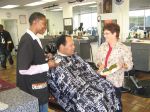Cancer is the second leading cause of death in Pennsylvania. Although the number of U.S. deaths from cancer dropped for the first time in 14 years in 2007, the mortality rate in Pennsylvania remains higher than for the nation as a whole. For African Americans, the statistics are even more concerning:
•African American men have a 25 percent higher incidence (rate of occurrence) and a 43 percent higher mortality (rate of death) for all cancer types combined than White men (refer to Figure 1).
•Although African American women have a lower incidence rate for all cancers combined than White women, they have a 20 percent higher mortality rate (refer to Figure 1).
•African Americans tend to be diagnosed at more advanced stages of cancer than Whites.
•African Americans have a lower five-year relative survival rate for almost every type of cancer than Whites at each stage of diagnosis.
Clearly, all Americans are not at equal risk for cancer, and disparities exist among certain groups that contribute to their disproportionately poor outcomes. Why do these disparities exist? As with many of the health conditions discussed in this series, cancer disparities are due in large part to adverse social conditions such as lack of access to good health care, disparities in educational attainment and poverty. Even with adequate access to care, African Americans are still at greater risk for poor outcomes in cases of colorectal and breast cancers. Edward Chu, MD, chief of the Division of Hematology/Oncology at the University of Pittsburgh School of Medicine and deputy director of the University of Pittsburgh Cancer Institute (UPCI), notes from his experience with colorectal cancer patients, “We’re finding that, stage for stage, African Americans and other minority populations have a more aggressive course than their Caucasian counterparts. There is still a lot that we don’t know about the genetics and biology of cancer, and that is why it’s critically important to have effective screening and early detection strategies and to include diverse populations in clinical research.”
What can we do—as policymakers, providers, insurers, community-based organizations, researchers, family members and individuals—to lower the risk of developing cancer and increase the odds of survival among African Americans? For the last two decades, Lyn Robertson, DrPH, RN, MSN, has worked with the African American community to address this challenge. As associate director of Cancer Community Outreach (CCO), a joint program of UPCI and UPMC Cancer Centers, Dr. Robertson heads a team of nurses and outreach coordinators committed to reducing the burden of cancer in underserved and minority populations through education, risk reduction, early detection and screening, elimination of barriers and research. “Disparities exist for many reasons, and the barriers to care that exist in one community may be very different in another community,” Dr. Robertson says. “It might be a transportation issue, lack of child care, a literacy problem, distrust of the medical establishment—we acknowledge these barriers and work with people to address them right there in their communities.”
Youth programs sponsored by CCO include Healthy Choices, an initiative for students in grades one through nine to learn about healthy lifestyle choices through health or science classes or after-school activities. The interactive, age-appropriate sessions promote physical activity and nutrition and discourage unhealthy habits like tobacco use. Summer youth programs are offered at community pools and recreation centers, where the message is sun safety.
Adult programs are more cancer-focused and include presentations on early signs and symptoms of common cancers, healthy lifestyle choices, weight management, nutrition, exercise and tobacco avoidance. Cancer screenings are often included. CCO collaborates with UPCI’s Center for Environmental Oncology to provide education about environmental risks for cancer such as pesticides, secondhand smoke, plastics and personal care products with cancer-causing ingredients.
“We stress the importance of making small changes to improve health and reduce cancer risk,” says Dr. Robertson. “Instead of soda, try seltzer mixed with fruit juice. If you eat fast food, order a salad with your burger instead of fries. Cut back from two drinks a day to one. When we meet people where they’re at, are not judgmental and encourage people to take baby steps to change their lifestyles, we can make big differences over time.” Dr. Robertson and her team are on the road constantly speaking at churches, barbershops, libraries and community centers across Western Pennsylvania. In addition, by partnering with local organizations like Healthcare for the Homeless, Gilda’s Club, YWCA, Salvation Army, Greater Pittsburgh Community Food Bank and the Carnegie Libraries of Pittsburgh, CCO provides assistance with scheduling appointments, obtaining medical coverage and securing transportation for an estimated 10,000 adults from underserved communities each year.
Cancer is a frightening diagnosis, but there are many resources available to help you and your family learn to cope, understand your options and find support. Take charge of your health today. Be informed. Be involved.
